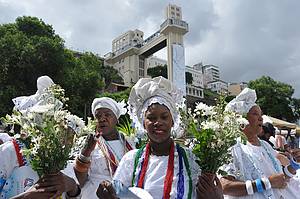About
The mixture of races, cultures and creeds, which received generous doses of joy and syncretism, gave the Savior a single astral and arretado attracting Brazilians and foreigners all year. It is in the summer, however, that the Bahian capital gains even brighter, with popular festivals which draw crowds behind religious images and of course, the electric trios. December to Carnival, many honored - Senhor do Bonfim to King Momo. Faithful and revelers thank!
The mixture of races, cultures and creeds, which received generous doses of joy and syncretism, gave the Savior a single astral and arretado attracting Brazilians and foreigners all year. It is in the summer, however, that the Bahian capital gains even brighter, with popular festivals which draw crowds behind religious images and of course, the electric trios. December to Carnival, many honored - Senhor do Bonfim to King Momo. Faithful and revelers thank!

Bonfim wash
First capital of Brazil, Salvador meets the present and the past in perfect harmony and, taking into account the topography of the city - divided into Upper and Lower - it's easy to map it and glimpse the attractive wide open on every corner.
It is in the high end is the colorful Pelourinho, the historic district and listed by Unesco as a World Heritage Site. In its streets and alleys are hundreds of houses of the 17th and 18th centuries that house museums to Candomblé, and Catholic churches that attract scholars from around the world - in the case of the San Francisco church, considered the richest baroque work of country.


Pelourinho
To reach downtown town it takes in, literally, in one of the postcards of Salvador: the Lacerda Elevator, which connects the two points. Once at sea, explore the beaches is crucial. Between urban, Porto da Barra is the most democratic and busy.
On the issue of food, by the way, offers go far beyond the cookie stuffed with vatapd and dried shrimp. Typical recipes that blend perfectly indigenous ingredients, African and Portuguese, lead the table delicacies like bobo, stew and pigweed, always scented by the oil-for-palm.


Acarajé Stew


Acarajé Stew
Spend 3 days in Salvador for just 5x $ 460,00!